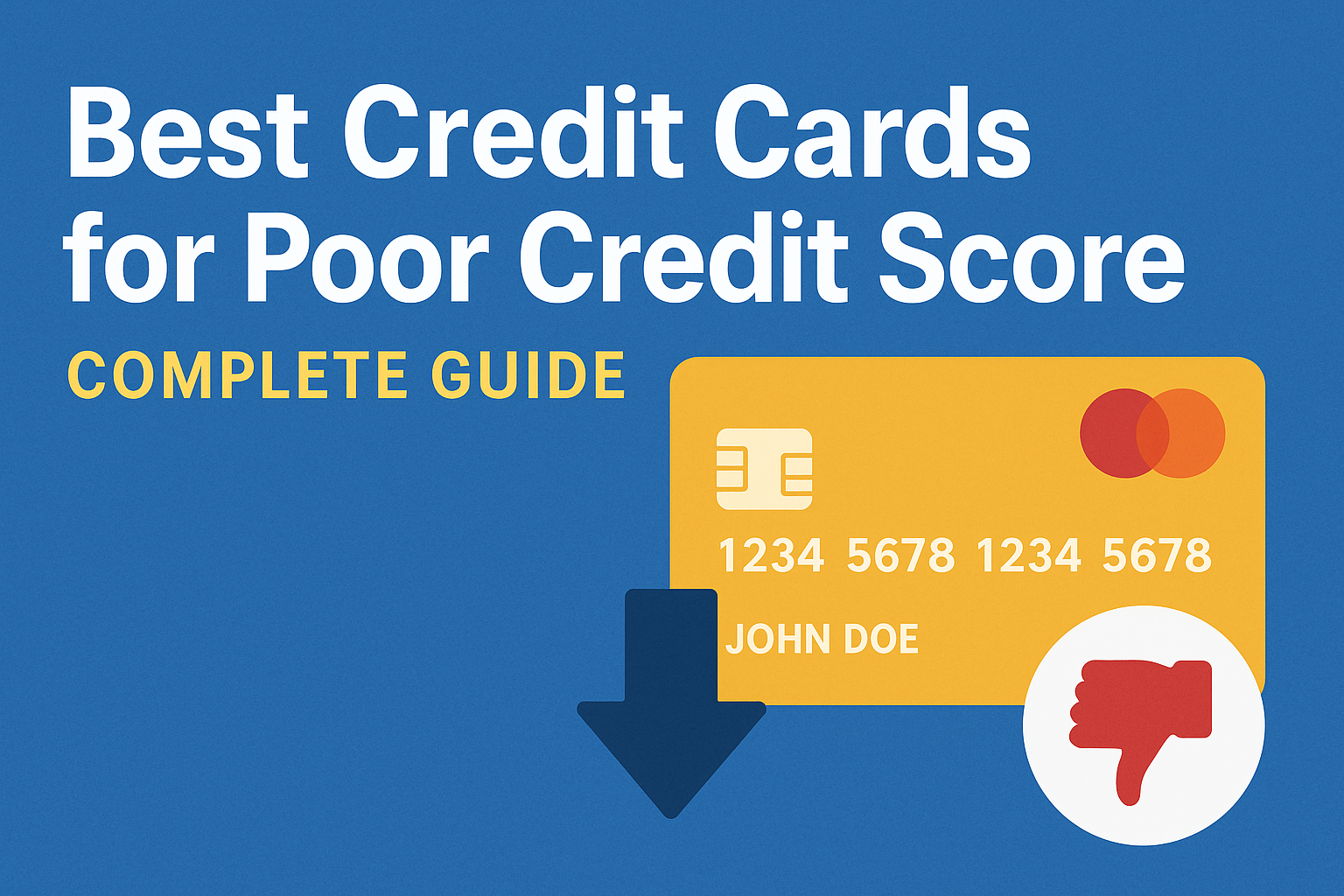A practical, step-by-step guide to finding the best credit cards for poor credit score, choosing the right product, avoiding pitfalls, and using a card to rebuild your credit responsibly.
Table of Contents
- 1. Introduction
- 2. What “poor credit score” means
- 3. Why getting a credit card with a poor credit score is hard
- 4. Types of credit cards suited for poor credit
- 5. Key features to look for (and avoid)
- 6. Risks and pitfalls
- 7. Best credit cards (by market)
- 8. How to evaluate offers and compare them
- 9. How to improve your credit score using a credit card
- 10. Step-by-step guide: applying & managing
- 11. Alternatives if you can’t get a credit card
- 12. FAQs
- 13. Conclusion
1. Introduction
If your credit history has blemishes — missed payments, a default, or simply a thin file — you may find mainstream credit products out of reach. The good news: there are credit cards and credit-building solutions designed specifically for people with a poor credit score.
This guide explains the types of cards available, what to look for (and avoid), lists common options across markets, and gives a clear action plan so you can rebuild your credit responsibly.
2. What “poor credit score” means
Credit scores differ by country and bureau. Broadly, a poor credit score means an increased risk to lenders, caused by:
- Late or missed payments
- Defaults or bankruptcies
- High credit utilisation
- Thin credit file (little or no credit history)
3. Why getting a credit card with a poor credit score is hard
Lenders respond to low scores with:
- Higher interest rates (APR)
- Lower credit limits
- Fees and stricter terms
- More scrutiny on income and affordability
4. Types of credit cards suited for poor credit
4.1 Secured (credit-builder) cards
You place a refundable deposit that usually sets your credit limit. They report to credit bureaus, so consistent on-time payments help rebuild credit.
4.2 Unsecured cards for bad credit
Some cards accept applicants with poor credit without a deposit. Low limits and high APRs are typical.
4.3 Guarantor / joint cards
A co-signer with stronger credit backs the card. Improves approval odds but risk lies with the guarantor.
4.4 Store cards / retail credit lines
Retailers sometimes offer easier credit access. Check whether they report to credit bureaus; otherwise, they won’t improve your score.
4.5 Prepaid or hybrid cards
Preloaded cards that may report payments to bureaus. Limited credit-building benefit but prevent overspending.
5. Key features to look for (and avoid)
Must-have:
- Reports to credit bureaus
- Soft eligibility check
- Low or no annual fee
- Reasonable APR
- Grace period
- Potential for credit-line increases
Avoid:
- No reporting to bureaus
- Excessive fees
- High APRs (60%+)
- Hidden penalties
- Opaque terms
6. Risks and pitfalls
- Interest accumulation
- Late/missed payments
- High utilisation
- Multiple applications
- Hidden fees
7. Best credit cards (by market)
7.1 United States — examples
- OpenSky® Secured Visa®
- Discover it® Secured
- Capital One Platinum Secured
- Avant / Reflex unsecured cards
7.2 United Kingdom — examples
- Aqua Classic
- Vanquis Credit Builder
- Capital One Classic (UK)
- Post Office / Tesco / Asda Foundation-style cards
8. How to evaluate offers and compare them
- Calculate effective cost: APR, fees
- Confirm bureau reporting
- Check grace period
- Look for limit growth
- Avoid cards with confusing fees or poor reviews
9. How to improve your credit score using a credit card
- On-time payments
- Keep utilisation low
- Pay in full every month
- Multiple payments to reduce balance
- Monitor credit reports
10. Step-by-step guide: applying & managing
- Check your credit report
- Use eligibility checks
- Apply for the right card
- Use responsibly (small purchases, on-time payments)
- Monitor reports and statements
- Upgrade when ready
11. Alternatives if you can’t get a credit card
- Credit-builder loans
- Guarantor loans
- Secured loans or savings-backed facilities
- Paying rent/utilities through reporting services
12. FAQs
- Will applying for a credit card hurt my credit score?
- Yes, a single hard inquiry slightly lowers your score. Use soft checks first.
- If I pay in full every month, do I avoid interest entirely?
- Usually yes, if the card has a grace period.
- How long does it take to rebuild credit using a card?
- Typically 6–12 months with consistent use.
- Can a secured card be upgraded to an unsecured one?
- Often yes, after good payment behaviour.
- Is it better to have a secured card or an unsecured bad-credit card?
- Secured cards are easier if you have a deposit; unsecured cards may have higher APRs and stricter limits.
13. Conclusion
The best credit cards for poor credit score are those that accept your current profile, report to bureaus, have reasonable fees, and offer a path to upgrade. Use small purchases, pay on time, keep utilisation low, and monitor progress. Over time, your credit options improve significantly.
Disclaimer: Informational purposes only. Always verify live terms and consult a financial adviser.

